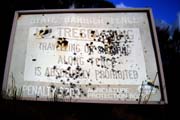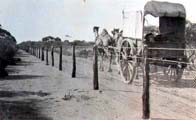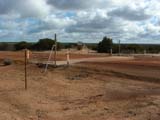 |
The State Barrier Fence
|

|
In 1859 rabbits were introduced to
Australia by keen shooters who imported 24 from England
and released them onto a Victorian property.
Doing what rabbits do so well, they quickly multiplied
and spread.
The spiralling population soon began to impact severely
on farmers, eating their crops and pastures.
By 1894 they had advanced across the
Nullabor Plain.
By 1901 the threat became so serious that it was decided
to erect a barrier fence to stop them invading the
agricultural lands of Western Australia.
|

|
Six years later the world's longest
fence had been constructed, with the "No 1 Fence" being
1'139 miles (1'822 km) in length.
Two adjoining fences (No 2 and No 3) were commissioned
in 1904 and 1906 as rabbits continued to make their
way west, and in all a total of 2'023 miles (3'237
km) of fence were constructed.
More than 400 men were employed in fence building
- a difficult task at the turn of the century, when
transport and materials were crude.
The fence was made of 4 plain wires and wire netting,
dipped in a tar mix to prevent rusting under the ground.
Fence posts were generally cut from trees adjacent
to the fence line, gates were installed every 20 miles
(32 km).
|

|
Under the management of the Department of Agriculture's
Chief Inspector of Rabbits, fence maintenance was
carried out by boundary riders who travelled the
fence line using bicycles, camel buggies and horse
drays.
For some 30 years the fence minimised the movement
of rabbits into agricultural areas.
With the decline in rabbit numbers in the late
1950s, due to the impact of poisoning and myxomatosis,
the fence was modified and realigned to protect agricultural
production from migrating emus.
|

|
Today the remaining fence (a composite of portions
of No's 1, 2 & 3) is known as the State Barrier
Fence.
It stretches 1'170 kilometres from north of Kalbarri,
around the perimeter of the agricultural districts
south to the coast near Hopetoun.
It also serves as a baiting corridor for wild
dogs and prevents the entry of feral goats.
In the event of an exotic disease outbreak it
would be a useful barrier to the movement of feral
or domestic animals.
|
|
|
No liability for timeliness, integrity and correctness of this document is accepted.
Last updated:
Thursday, 20.03.2008 12:36 PM
|
|
|